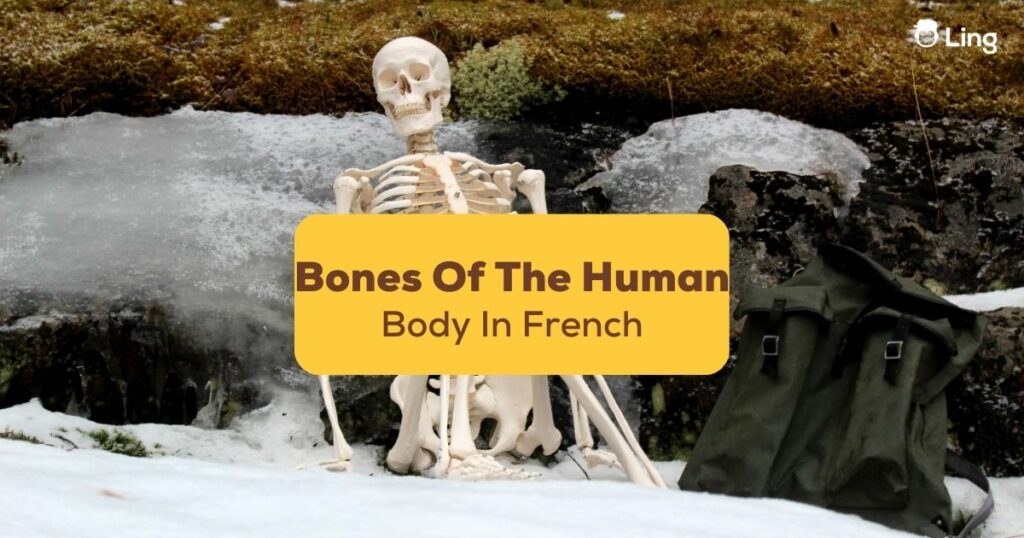Os du corps humain en français, or the bones of the human body in French, are terribly important when it comes to keeping all the other body parts from flopping around all over the place. This time we will be taking a look at body parts in French, especially the bones, and learning a bit more about how useful they are in holding everything about our bodies together.
The Skeletal System In French
To delve into the world of French bone-related terms, it is crucial to have a basic understanding of the skeletal system. In French, the skeletal system is referred to as “le système squelettique” or “l’appareil locomoteur.” This system comprises different types of bones that provide structure, support, and protection to “le corps” (the body).
Vocabulary For Major Bones (Des Os)
Cranium – Le Crâne
The skull, or “le crâne,” is the protective bony structure that houses the brain. It is made up of several bones, including the frontal bone (os frontal), the parietal bones (os pariétal), the occipital bone (os occipital), and the temporal bones (os temporal). As well as housing the brain, the skull helps to give shape to la tête (head), and le visage (face). It also makes sure les cheveux (hair) stays mainly on the top of our heads, and les yeux (eyes) don’t fall out.
Femur – Le Fémur
The femur, or “le fémur,” is the largest bone in the human body, located in the upper leg. It connects the hip joint to the knee joint and plays a crucial role in supporting the weight of other body parts as we move about.
Humerus – L’Humerus
L’humerus, or the humerus, is the long bone found in the upper arm or forelimb on either side of the upper body. It extends from the shoulder to the elbow, forming part of the shoulder and elbow joints. Les mains (hands) can be located at the end of le bras (arms) and are extremely helpful body parts when it comes to catching things, picking things up, or typing this blog.
Tibia – Le Tibia
Le tibia, or the tibia, is the larger of the two bones in the lower leg, commonly known as the shinbone. It plays a crucial role in supporting body weight and acts as a major site for muscle attachment.
Fibula – La Fibula
La fibula, or the fibula, is the smaller of the two bones in the lower leg. It runs parallel to the tibia and plays a supporting role in providing stability and muscle attachment.

Bone-Related Phrases
“Avoir Les Os Solides”
The French expression “avoir les os solides” translates to “to have strong bones.” This phrase is used metaphorically to describe someone who is physically strong or resilient. It is also a phrase used to promote milk for its calcium as a builder of strong bones and to sell vitamin pills.
“Casser Les Os”
The phrase “casser les os” literally means “to break bones” in French. Figuratively, it is used to describe a challenging or difficult situation that requires significant effort to overcome. “Des bâtons et des pierres pourraient me casser les os…” “Sticks and stones may break my bones…” is the first line of a body part related poem about how harsh words can be just as hurtful, if not more so, as physical pain.
“Rire À Se Tordre Les Os”
Translated as “to laugh until your bones twist,” this phrase depicts extreme laughter. It implies that the laughter is so intense that it causes physical discomfort until your head hurts and your internal organs ache.
Anatomical Terminology
“Articulation” – Joint
The term “articulation” is used in French to refer to a joint, where two or more bones come together. It encompasses various types of joints, such as hinge joints (articulation à charnière) and ball-and-socket joints (articulation sphéroïde).
“Cartilage” – Cartilage
“Cartilage” is the same word in French and English and refers to the firm, flexible connective tissue found between bones in many parts of the body. It provides cushioning and reduces friction in joints.

Medical Professions Related To Bones
“Orthopédiste” – Orthopedist
An orthopedist, or “un orthopédiste,” is a medical professional who specializes in the treatment of bone and joint disorders. They diagnose, manage, and provide surgical or non-surgical interventions for musculoskeletal conditions.
“Rhumatologue” – Rheumatologist
A “rhumatologue” is a rheumatologist, a medical specialist who focuses on the diagnosis and treatment of diseases affecting the joints, muscles, and bones. They address conditions such as arthritis, osteoporosis, and autoimmune disorders.
A Recap Of The Bones Of The Human Body In French
French Names For Arm Bones
| English | French | Sound |
| Collar bone | La clavicule | |
| Shoulder blade | L’omoplate | |
| Humerus | L’humérus (m | |
| Ulna | Le cubitus | |
| Radius | Le radius |
French Vocabulary For The Bones Of The Leg
More Bone Names In French
| English | French | Sound |
| Skull | Le crâne | |
| Spine | La colonne vertébrale | |
| Vertebra | Une vertèbre | |
| Sternum | Le sternum | |
| Rib cage | La cage thoracique | |
| Rib | Une côte | |
| Pelvis | Le pelvis, le bassin |
Learn More French Parts Of The Body With Ling App
Whether you have a professional interest or are just keen to increase your French vocabulary, Ling app has plenty of blogs and lessons, including French words and phrases related to the human body.
With more than 60 other languages to explore, Ling app is a one-stop service for anyone who wants to learn another language at a pace that suits them. Try Ling app today by visiting Google Play or the App Store.



































































